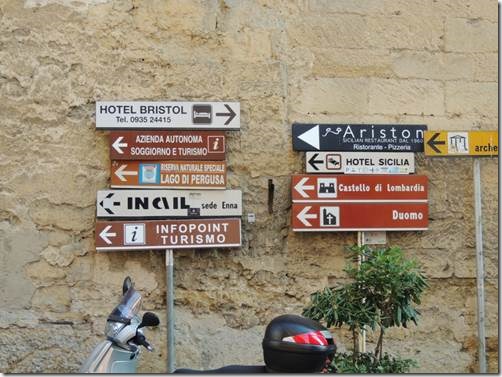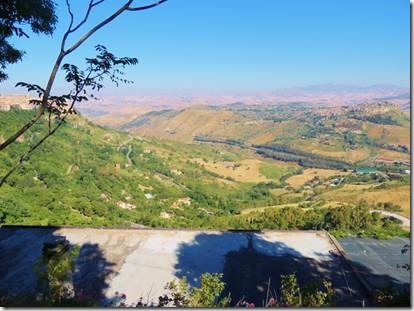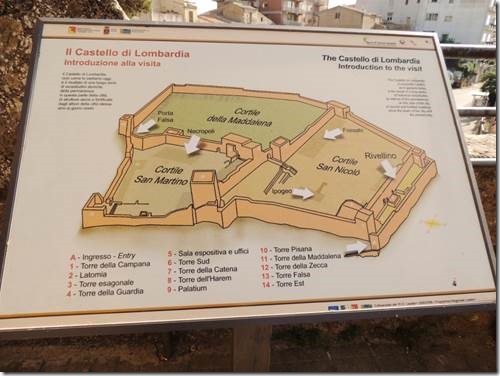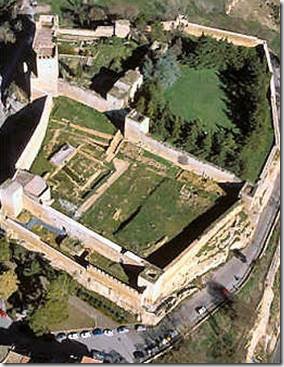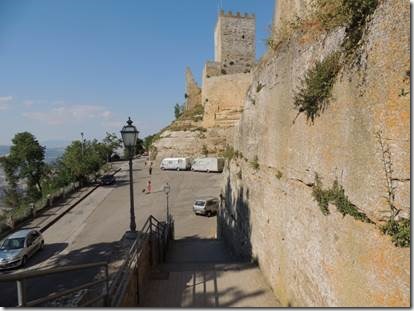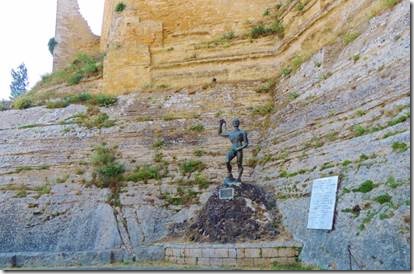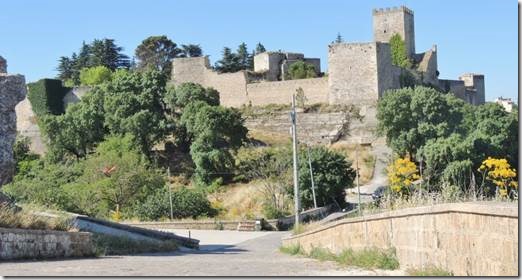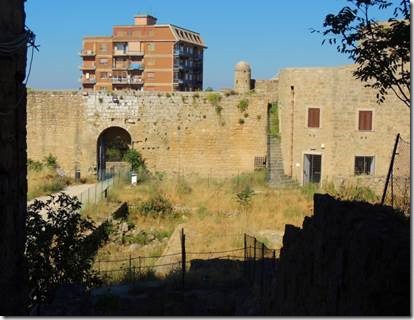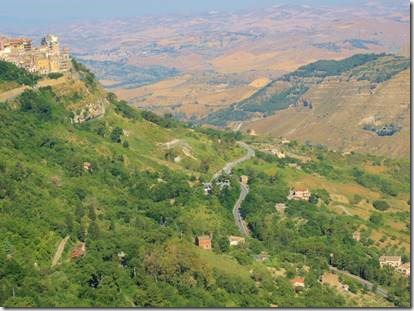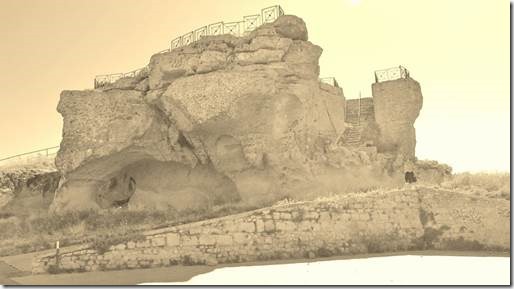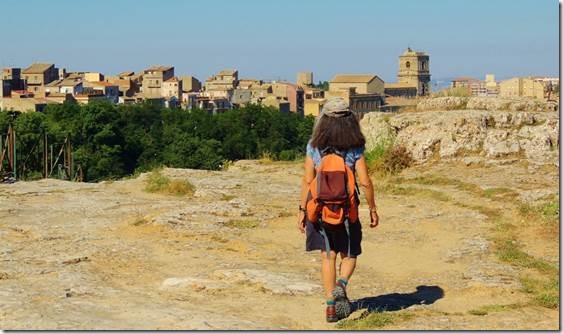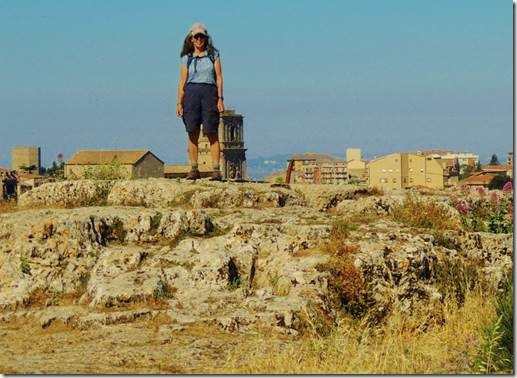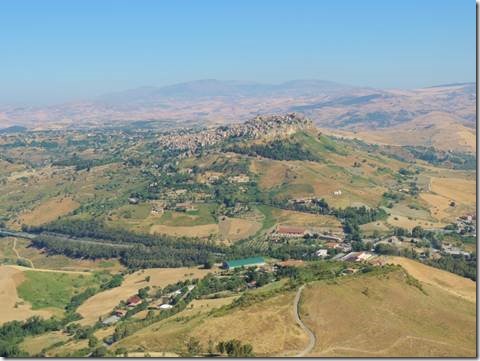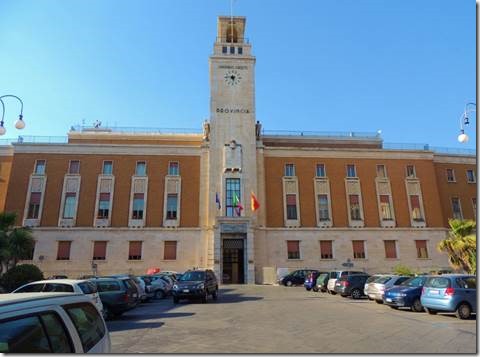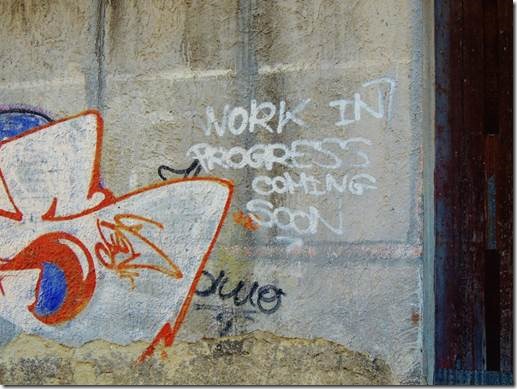Buongiorno,
No castle has caught my imagination like our first visit to Kyrenia Castle in North Cyprus. Perhaps the motorbike ride up the mountain taking us there added to the drama of the setting. So Castle Lombardo wasn’t my favorite attraction in Enna but it was on my list and Randal does like castles, so we went. I saw lots of folks walking there the first evening I visited. As for the Rock of Ceres, I wanted to see it and we did! Did I feel the spirit of Demeter? No, can’t say that I did. But it was a lovely setting and she was the goddess of nature, so who can say. You can certainly see what may have inspired the myths, stories once used to explain the world to ourselves before we had science. Now the myths add to our reasons for travel to see where they were created and the landscape that inspired them.
Ru
Castello di Lombardi
Enna’s main attraction is the Lombard Castle, built by Frederick II in the early part of the 13th century. Many historians, however, agree that the castle was erected upon the ruins of an earlier fortification, possibly Arab or Byzantine. That older fortress could have been built on the remnants of an even earlier structure dating to the Roman period. http://www.bestofsicily.com/enna.html
Situated on East most point of Enna, the site has been fortified since earliest times because of its strategic position. Under Norman dominion, the castle was reinforced. It was made habitable by Frederick II Aragon, who added a number of rooms that rendered it suitable. It was here that He was crowned King of Trinacria and in 1324, convocated the Sicilian parliament. The name of the castle dates back to the same period linked to the presence of a garrison of Lombard soldiers posted there to defend it. The ground plan is of pentagonal which follows the lay of the land. Of the 20 towers only 6 remain. The most interesting and complete tower is called La Pisana or Torre delle Aquile (The Pisan Tower or of the Eagles).
Under the Spanish control in the 16th and 17th century, Enna strategic importance was diminished and the castle was used a prison. It fell in a bad state of despair, in the 20th century, archaeologist Paolo Orsi began excavation and restoration work.
http://www.sicilianexperience.com/history.php?codice=enna
|
The Hotel Bristol was locked up tight so we stayed in the Hotel Sicilia |
|
Walking up to the Castello di Lombardia |
|
Vicissitudes : favorable or unfavorable event or situation that occurs by chance http://www.merriam-webster.com/dictionary/vicissitude My 8th grade English teacher who was also my 9th grade Latin teacher used to say, “Such my friends are the vicissitudes of life which we must all endure.” Vicissitudes isn’t a word you hear or read everyday so I thought it was a surprise to see it here. |
|
Photo from http://www.sicilyontour.com/ which has additional info and photos |
|
Behind the vans is the statue of Euno and the tall crenellated Torre Pisana |
|
Looking back at the castle from the road to Rocca Di Cerere |
|
Old and new… |
|
Looking back to Enna and the road we drove to get there |
|
Ceres Rock in Black and White : we walked to the top where the views were stunning. The Siculians made Enna one of the main sacred centres for the cult of Ceres in honour they built a sacred fence and a sanctuary on the eastern slope of the mount. Traces, mostly imaginable, are in the Ceres Rock, at the foot of the Lombard Castle. |
|
Rock of Ceres Walking to the very top where you can easily imagine some type of temple stood. You can see the top of the Duomo in the Enna skyline. “Enna is a very old city, and a temple to Demeter stood on the rocky mount near its Lombard Castle, overlooking the plains and mountains below. In his Hymn to Demeter, Homer recounts the story of Persephone. It is much embellished over time, with local versions featuring details unknown to the ancients.” http://www.bestofsicily.com/mag/art45.htm (full article below) |
|
Somewhere out there is Lake Pergusa (a great place for bird watching Charmaine and Linda) The Pergusa Lake, the only natural lake in central Sicily, is located 5 km from Enna, and has originated due to a subsidence of the land. According to the mythological story of the abduction of Proserpina, daughter of Ceres, on the part of Pluto, is believed to be one of the gates of hell, perhaps for the red color that its waters are in some periods of the year. Brackish water coming from rain only because the lake has no tributaries or emissaries. Since 1995, the lake and the environment surrounding Pergusa are a Special Nature Reserve to protect, according to the official justification, of a lake that is home to a rich variety of bird life and is the only wetland of stopping in the heart of Sicily, for migratory birds. Between April and May and between October and November Pergusa becomes a real crossroads for birds, due to its geographical position and for being an oasis in a wet landscape for many months dominated by the drought. Pergusa represents the ideal habitat for birds that make long hours of uninterrupted flight over the sea to and from Africa. Periodically, the lake, for a synergy between some of the microscopic organisms that live in it, has a unique phenomenon: its waters are tinged with red. Protagonists of this phenomenon is a little "shrimp" that, to defend himself from the rays of summer sun, is tinged with red pigment and is setting up in dense colonies in the aquatic plants. The pigment is then transferred to water and bacteria in it to give up the mirror of the lake a reddish color |
|
Enna’s modern government building. |
|
Oxymoron but clever |
“Today, the typical young Sicilian woman stands about five feet five inches. If not a goddess, she’s shapely but not overweight, perhaps rather stylish, and spends most of July and August at the beach. She finds her first employment of any kind at around twenty-six, following an interrupted year or two of specialized higher education. In a sexist society, she’s slightly left of center politically and opposes the death penalty (which anyway doesn’t exist in Italy). Having studied in Italy’s schools, she believes that an Italian named Meucci invented the telephone. A non-practicing Catholic, she nevertheless marries in a lavish religious ceremony at thirty-two after a lengthy courtship.
Persephone’s courtship, by comparison, was a last minute affair, though she had little need for religious ceremonies. In mythology, she was the beautiful daughter of Zeus, king of the gods, and Demeter (Ceres), goddess of agriculture and fertility. While gathering flowers in the Valley of Enna, Persephone, who is also known as Kore (Greek for "maiden") was abducted by Hades and taken to the underworld. Having lost her daughter to this dark realm, Demeter descended into sorrow, losing interest in the mortals and their agriculture, and Zeus had to intervene to bring an end to the famine that resulted from this abandonment. This he did by ordering Hades to release Kore, but not before the maiden had consumed a pomegranate seed as a sign of fidelity to Hades. That meant that she had to spend at least four months of every year with Hades, by whom she had a son, Plutus.
Kore became the goddess of grain (wheat), and her annual absence was meant to account for the barren winter fields. Her cult was widespread, particularly at Enna, and Lake Pergusa is sometimes identified as the place where she was abducted or raped by Hades. She appears in several Greek myths and was worshipped at Eleusis in Attica.
The allegory of Persephone is timeless. Grain sprouts to life from the earth to be harvested by man in the same way that a nubile girl is taken from her parents and her virginity lost to bring forth new life. Persephone’s case may have been rather extreme, but the principle is unchanged. Her story dates at least from 700 BC, when the first Greek colonies were established in Sicily. Enna is a very old city, and a temple to Demeter stood on the rocky mount near its Lombard Castle, overlooking the plains and mountains below. In his Hymn to Demeter, Homer recounts the story of Persephone. It is much embellished over time, with local versions featuring details unknown to the ancients.
Persephone’s renewal is not unlike nature’s, and through the myth, human life is said to imitate nature itself. The imagery and message are purely Greek, but the earliest legend may have been Sicilian. It has been suggested that Persephassa, an earlier name for Persephone, indicates a pre-Hellenistic origin, and possibly a Sicanian or Sicel one. This may explain the early existence of a cult to this goddess in east-central Sicily coinciding with the Greeks’ first incursions into the region and their gradual amalgamation with the native peoples.
To the Romans, she was Prosperina, and that is how she is known to Italians. Her Latin name shares the root of the word meaning "to prosper."
About the Author: Palermo native Vincenzo Salerno has written biographies of several famous Sicilians, including Frederick II and Giuseppe di Lampedusa.

